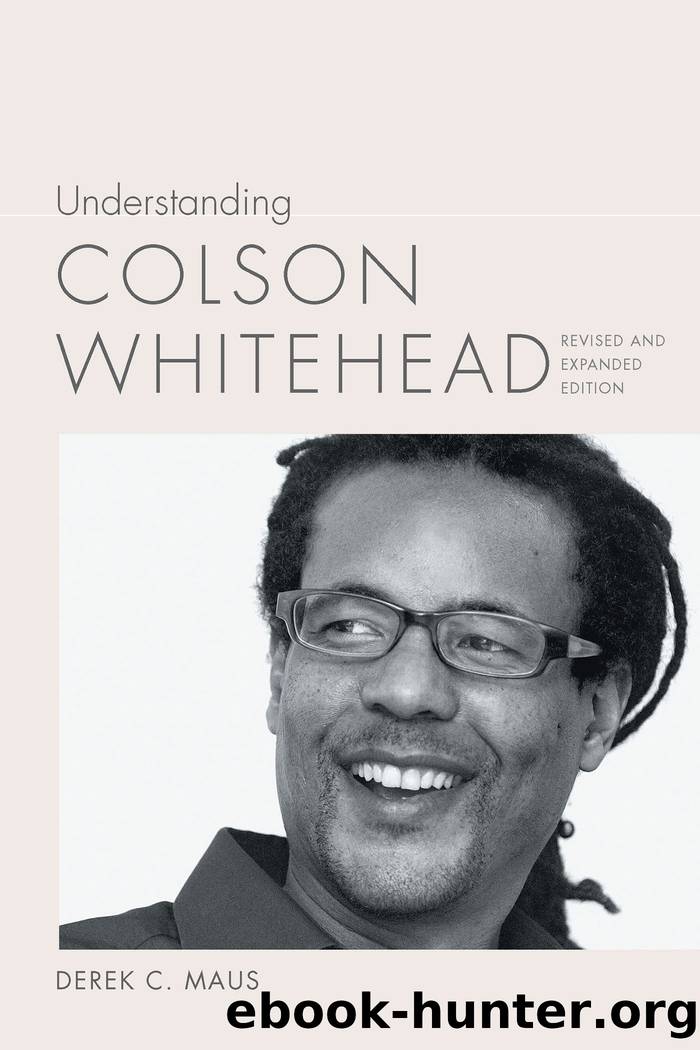Understanding Colson Whitehead by Derek C. Maus;

Author:Derek C. Maus;
Language: eng
Format: epub, pdf
Publisher: University of South Carolina Press
Published: 2021-06-15T00:00:00+00:00
CHAPTER 5
Whiteheadâs âNew York Trilogyâ
The Colossus of New York, Sag Harbor, and Zone One
Although it is the novelist Paul Auster who published a book bearing the title The New York Trilogy (1987), three of Whiteheadâs remaining books constitute a collective commentary on âNew York, the city, where itâs going, where itâs beenâ (Goble 65). Although there is no indication that Whitehead envisioned formally grouping these works together as a literary trilogy, there are enough thematic overlaps among The Colossus of New York: A City in Thirteen Parts (2003), Sag Harbor (2009), and Zone One (2011) to justify examining them as a unit.
As Phillip Lopate noted in his review of The Colossus of New York, Whitehead has âalways written about New Yorkâ to some extent; although never explicitly named, the Manhattan-like urban setting of The Intuitionist is âa mythological, stylized backdrop of power and corruption, similar to Gotham in Tim Burtonâs Batman film.â Likewise, New York is âthe fallback media-hype centerâ (Lopate) from which both J. Sutter in John Henry Days and the protagonist of Apex Hides the Hurt venture outward into a Middle America that they loathe and only barely comprehend. Each of the three books considered in this chapter, however, features Whiteheadâs native New York (and related outlying places) as a more integral part of both its geographical and cultural settings.
Especially after staging a zombie apocalypse in his hometown in Zone One, Whitehead has frequently been asked about his feelings toward New York. Although his affinity for the city is unmistakableââIâm definitely a New Yorkerâ¦. Iâve tried living other places, but I always end up coming back hereâ (Porter 25)âhis answers also indicate a dynamic tension between love and loathing. In discussing Zone One, Whitehead wryly noted that âthe city has shaped how I see the world, move through the world. I donât think it will come as a surprise that my view of New York after everybodyâs dead is not too far from how I perceive New York now, when everybodyâs deadâI mean, trying to make it through the dayâ (Madrigal). In another interview Whitehead mentioned writing about the simultaneously vibrant and violent New York of the 1970s in which he came of age: âIt was so dirty, you were constantly on guard from predators, and itâs so cleaned up now that thinking about how it used to be with the danger and the garbage and buildings on fireâ¦. That old New York is gone, and thatâs one thing thatâs undiscoverable now but I explore in my fictionâ (Shukla 103).
These ambivalent feelings shape literary settings that evoke tangible, distinctive aspects of New York while also serving as symbolic microcosms. Even though New York has been his home for all but a few years of his life, Whitehead is adamant that the localized, mildly autobiographical dimensions of the three books he has set there do not supplant broader identifications that his readersâNew Yorkers or notâmight make with his plots and characters. He made this clear in discussing The Colossus of New York with Evette Porter: âI think I identify myself with the metropolis.
Download
Understanding Colson Whitehead by Derek C. Maus;.pdf
This site does not store any files on its server. We only index and link to content provided by other sites. Please contact the content providers to delete copyright contents if any and email us, we'll remove relevant links or contents immediately.
4 3 2 1: A Novel by Paul Auster(11790)
The handmaid's tale by Margaret Atwood(7448)
Giovanni's Room by James Baldwin(6809)
Asking the Right Questions: A Guide to Critical Thinking by M. Neil Browne & Stuart M. Keeley(5356)
Big Magic: Creative Living Beyond Fear by Elizabeth Gilbert(5352)
Ego Is the Enemy by Ryan Holiday(4957)
On Writing A Memoir of the Craft by Stephen King(4663)
The Body: A Guide for Occupants by Bill Bryson(4583)
Ken Follett - World without end by Ken Follett(4443)
Bluets by Maggie Nelson(4261)
Adulting by Kelly Williams Brown(4234)
Eat That Frog! by Brian Tracy(4149)
Guilty Pleasures by Laurell K Hamilton(4116)
White Noise - A Novel by Don DeLillo(3829)
The Poetry of Pablo Neruda by Pablo Neruda(3815)
Fingerprints of the Gods by Graham Hancock(3738)
Alive: The Story of the Andes Survivors by Piers Paul Read(3730)
The Book of Joy by Dalai Lama(3697)
The Bookshop by Penelope Fitzgerald(3619)
